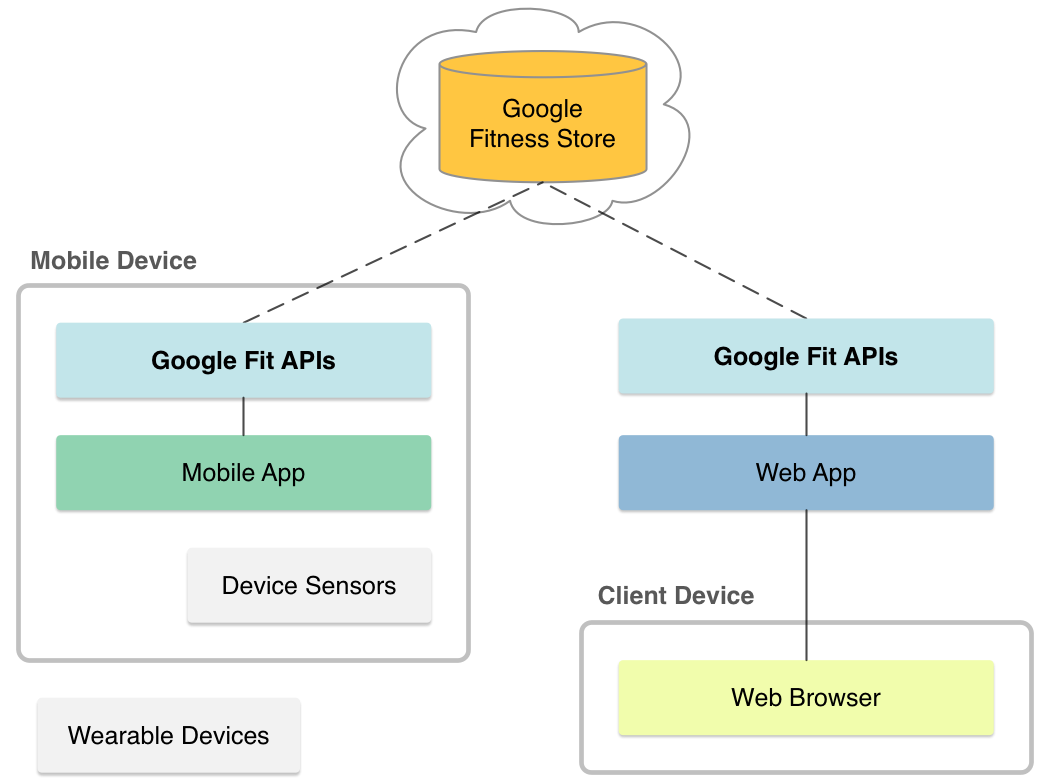Google 피트니스는 개방된 생태계입니다. 이를 통해 개발자는 건강 및 웰빙 데이터를 중앙 저장소에 업로드할 수 있으며, 사용자는 여기에서 여러 기기와 앱의 데이터를 한 곳에서 액세스할 수 있습니다. 새 기기로 업그레이드해도 데이터에 액세스할 수 있습니다.
건강 및 웰빙 앱은 모든 웨어러블 또는 센서의 데이터를 저장하고 다른 앱에서 생성된 데이터에 액세스할 수 있습니다.
Google 피트니스 개발자 및 사용자 데이터 정책을 꼼꼼히 읽고 앱이 이를 준수하는지 확인합니다. Google 피트니스를 사용하기 전에 Google 피트니스 이용약관을 주의 깊게 검토하세요. API를 사용하면 Google 피트니스 이용약관에 동의하는 것으로 간주됩니다.
구성요소
Google 피트니스는 다음과 같은 요소로 구성됩니다.

- 피트니스 매장
- 다양한 기기와 앱의 데이터를 저장하는 중앙 저장소입니다. 피트니스 스토어는 클라이언트에게 투명한 클라우드 서비스입니다.
- 센서 프레임워크
- 피트니스 스토어를 쉽게 사용할 수 있는 상위 수준 표현 집합입니다. Google Fit API와 함께 이러한 표현을 사용합니다.
- 권한 및 사용자 제어
- 건강 및 웰빙 데이터를 사용할 수 있도록 사용자 권한을 요청하는 승인 범위 모음입니다. Google 피트니스에서 건강 및 웰빙 데이터에 액세스하려면 사용자 동의가 필요합니다.
- Google Fit API
- 피트니스 스토어에 액세스하기 위한 Android 및 REST API. Android, iOS, 웹 앱과 같은 여러 플랫폼과 기기에서 Google 피트니스를 지원하는 앱을 만들 수 있습니다.
피트니스 매장
피트니스 스토어는 Google의 인프라를 사용하여 건강 및 웰빙 데이터를 유지하는 클라우드 서비스입니다. 다양한 플랫폼과 기기의 앱은 데이터를 저장하고 다른 앱에서 만든 데이터에 액세스할 수 있습니다. Google 피트니스는 쉽게 데이터를 삽입하고 피트니스 매장을 쿼리할 수 있는 API 세트를 제공합니다.
센서 프레임워크
센서 프레임워크는 센서, 데이터 유형, 데이터 포인트 및 세션의 상위 수준 표현을 정의합니다. 이러한 표현을 사용하면 모든 플랫폼에서 피트니스 스토어와 쉽게 작업할 수 있습니다.
- 데이터 소스
- 데이터 소스는 센서를 나타내며 이름, 수집된 데이터 유형, 기타 센서 세부정보로 구성됩니다. 데이터 소스는 하드웨어 센서 또는 소프트웨어 센서를 나타낼 수 있습니다. 앱에서 소프트웨어 센서를 정의할 수 있습니다.
- 데이터 유형
- 데이터 유형은 걸음 수나 심박수와 같은 다양한 종류의 건강 및 웰빙 데이터를 나타냅니다. 데이터 유형은 여러 앱이 서로의 데이터를 이해할 수 있는 스키마를 설정합니다. 데이터 유형은 이름과 정렬된 필드 목록으로 구성되며, 각 필드는 측정기준을 나타냅니다. 예를 들어 위치의 데이터 유형에는 3개의 필드 (위도, 경도, 정확성)가 포함되지만 가중치의 데이터 유형에는 필드가 하나만 포함됩니다.
- 데이터 포인트
- 데이터 포인트는 데이터 소스에서 읽은 데이터 유형에 대한 타임스탬프가 적용된 값 배열로 구성됩니다. 데이터 포인트를 사용하여 건강 및 웰빙 데이터를 기록 및 피트니스 스토어에 삽입하고, 데이터 소스에서 원시 데이터를 읽습니다. 시작 시간이 포함된 지점은 즉각적인 측정 대신 기간을 나타냅니다.
- 데이터 세트
- 데이터 세트는 특정 시간 간격을 두고 특정 데이터 소스에서 가져온 동일한 유형의 데이터 포인트 집합을 나타냅니다. 데이터 세트를 사용하여 피트니스 저장소에 데이터를 삽입합니다. 피트니스 저장소에서 데이터를 읽는 쿼리도 데이터 세트를 반환합니다.
- 세션
- 세션은 사용자가 달리기, 자전거 타기와 같은 피트니스 활동을 하는 시간 간격을 나타냅니다. 세션은 피트니스 활동을 위해 피트니스 저장소에서 데이터를 정리하고 상세 쿼리 또는 집계 쿼리를 실행하는 데 도움이 됩니다.
권한 및 사용자 제어
Google 피트니스에서 앱이 건강 및 웰니스 데이터를 읽거나 저장하려면 먼저 사용자 동의를 받아야 합니다. Google 피트니스는 활동, 신체, 위치, 영양 및 건강 관련 데이터 유형과 같은 별도의 읽기 및 쓰기 권한을 가진 여러 권한 그룹에 매핑되는 OAuth 범위를 정의합니다 (건강 관련 데이터 유형은 더 세부적으로 그룹화됩니다). 각 권한 그룹은 데이터 유형 집합에 대한 액세스 권한을 앱에 부여합니다. 앱에서는 건강 및 웰빙 데이터를 사용할 범위를 하나 이상 지정하고, Google 피트니스는 사용자에게 해당 권한을 요청합니다.
Google Fit API
Google 피트니스는 다음 API를 제공합니다.
- Android 앱용 Android API
- REST API는 모든 플랫폼의 앱에 사용할 수 있습니다.

